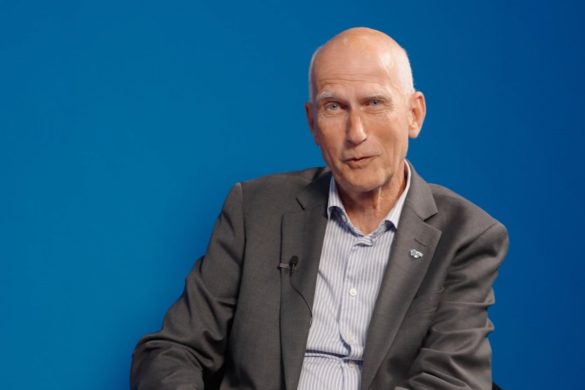 Kennedy Lees is Professor of Cerebrovascular Medicine at the University of Glasgow, UK. He is President of the European Stroke Organisation.
Kennedy Lees is Professor of Cerebrovascular Medicine at the University of Glasgow, UK. He is President of the European Stroke Organisation.
Gian Luigi Lenzi (GLL): As President of the European Stroke Organisation, can you illustrate the role you would like EAN to cover within the world of European Neurology?
Kennedy Lees (KL): EAN should represent specialists in neurology to ensure that their contribution to stroke care is recognised, and in countries where this is under-represented should work to promote their involvement. It should offer an educational function, teaching general neurologists about the latest and most important aspects of stroke that they may encounter in their practice. It should promote stroke guidelines among its members and help to ensure that these are followed. EAN’s conferences should appropriately acknowledge stroke and ESO through inclusion of relevant topics and joint sessions; equally, EAN should encourage attendance at ESO conferences and should contribute to the education of stroke specialists – of any background discipline – on relevant neurological topics and advances. EAN should act as a bridge among these neurological specialty organisations, helping with communication, education and political tasks.
GLL: EAN aims at being the overall umbrella for Neurology and Neurology related specialties. How do you see ESO working together with EAN?
KL: These are equal partners in European medicine. Just as EAN covers a range of neurological specialties, ESO also represents a broad church. In some European countries, acute stroke is managed by vascular neurologists whereas in others, internal physicians, geriatricians, cardiovascular physicians, clinical pharmacologists have taken the lead. In coming months, interventional neuroradiologists are likely to play an increasing role. Beyond the acute phase, rehabilitation of stroke involves geriatricians, rehabilitation specialists and several professions allied to medicine. Prevention of stroke is considered by neurologists, cardiovascular physicians/ cardiologists, geriatricians, internal medicine specialists and vascular surgeons. ESO needs to work in partnership with EAN because there are many neurologists who continue to undertake general neurology beyond stroke, but it needs to work with other specialist European and national societies. Where guidelines are being developed that have common interest between ESO and EAN there ought to be joint membership and a unified message. The conferences of the two societies should each have joint sessions targeting education and shared research interest. Political influence on vascular neurology issues should be harmonised but its impact may be stronger if the two societies each send a unique representative. ESO will strive to avoid conflicts with regard to funding opportunities and we hope that EAN will do likewise: stroke and vascular neurology will be principally the remit of ESO whereas general neurological opportunities should be left to EAN.
GLL: What is your view on the future of the educational grants for young neurologists? Can you see possible co-operation between ESO and EAN in this field?
KL: ESO has a strong educational mission and offers summer schools, winter schools, department to department visits and teaching sessions within conferences. Young neurologists need to be encouraged to consider stroke as an important element of their training and future career, and perhaps to specialise in stroke. EAN grants may greatly assist with this process, and ESO could investigate ways to bring added value to such grants that are directed towards ESO activities, for example by publicising them, by cooperating over selection of candidates and by discounting costs for ESO activities.
GLL: Can you share with our readers your vision on how Neuropenews can help strengthen EAN’s identity?
KL: Though neurologists may presently be aware of Neuropenews, this is not yet something that has reached all branches of stroke medicine, nor all countries. Thus, EAN will wish to work with other societies, not just ESO, to demonstrate what EAN offers to these related fields. Since EAN covers a wide range of neurological interests, it could help if it first indicates how it sees its role in supporting the work of disease-related associations.
GLL: EAN is publishing Guidelines that receive a large number of quotations, indicating that they appear interesting to many Neurologists. Is it possible to think to cooperation between ESO and EAN for Stroke Guidelines?
KL: ESO is responsible for the European Stroke Guidelines and leads their development. It already works with a number of organisations to develop stroke guidelines where there are common interests. For example, ESO cooperates with the European Society of Cardiology on AF guidelines. ESO has a rigorous approach to guideline development and a policy on committee membership that envisages membership from relevant specialty groups. Cooperation with EAN in relevant areas is greatly welcomed and proposal of topics that would be appropriate is invited.
GLL: EAN has been founded in June 2014, from the two previously existing European Societies, ENS and EFNS. We feel that this unity will give more strength to European Neurology. Do you think that this unity could be achieved in the field of Stroke in Europe?
KL: ESO is already the sole voice of the clinical and academic groups for stroke in Europe. It has established its own conference, following its stated principles of democracy, financial transparency, scientific quality and compliance with CME standards. The first of these annual conferences will be held in Glasgow, April 17-19 2015. Support for this has been vigorous and widely expressed, including endorsement from the World Stroke Organisation. ESO runs a summer school, a winter school, a master’s course, a stroke science workshop and a guidelines meeting. So many specialty groups beyond neurology need to contribute to the care of stroke patients that it is unreasonable to expect that these associations would be subsumed by ESO. However, as the voice of the scientific and clinical leadership for stroke in Europe, ESO stands alone.
GLL: Thank you for your time!













